In 1694 the Jesuit Father Kino heard of the ruin, and later in the same year visited it and said mass within its walls. His secretary and usual companion on his missionary journeys, Mange by name, was not with him on this occasion, but in 1697 another visit was paid to the ruin and the description recorded by Mange[1] in his diary heads the long list of accounts extending down to the present time.[2] Mange describes the ruin as consisting of—
A large edifice, the principal room in the center being four stories high, and those adjoining it on its four sides three stories, with walls 2 varas thick, of strong argamaso y baro (adobe) so smooth on the inside that they resemble planed boards, and so polished that they shine like Puebla pottery.
[Footnote 1: An English translation is given by H. H. Bancroft, Works, iv, p. 622, note. Also by Bartlett, Personal Narrative, 1854, vol. ii, pp. 281-282; another was published by Schoolcraft, Hist. Cond. and Pros. of Am. Ind., vol. iii, 1853, p. 301.]
[Footnote 2: Quite an
extensive list is given by Bancroft
(op. cit., pp. 622-625, notes),
and by Bandelier in Papers Arch.
Inst. of Amer., American series,
i, p. 11, note.]
Mange also gives some details of construction, and states that in the immediate vicinity there were remains of twelve other buildings, the walls half fallen and the roofs burned out.
Following Mange’s account there were a number of descriptions of no special value, and a more useful one written by Padre Font, who in 1775 and 1776 made a journey to Gila and Colorado rivers and beyond. This description[1] is quite circumstantial and is of especial interest because it formed the basis of nearly all the accounts written up to the time when that country came into our possession. According to this authority—
The house forms an oblong square, facing exactly the four cardinal points, and round about it there are ruins indicating a fence or wall which surrounded the house and other buildings. The exterior or plaza extends north and south 420 feet and east and west 260 feet.
[Footnote 1: A number of copies of Font’s Journal are known. Bancroft gives a partial translation in op. cit., p. 623, note, as does also Bartlett (op. cit., pp. 278-280); and a French translation is given by Ternaux Compans, ix, Voyages de Cibola, appendix.]
Font measured the five rooms of the main building, and recorded many interesting details. It will be noticed that he described a surrounding wall inclosing a comparatively large area; and nearly all the writers who published accounts prior to our conquest of the country in 1846 based their descriptions on Font’s journal and erroneously applied his measurement of the supposed circumscribing wall to the Casa Grande proper.




